How to Set Up a Factory in Malaysia: A Step-by-Step Guide
Discover the essential steps to establish a factory in Malaysia, from planning to sustainability practices.

Overview:
To set up a factory in Malaysia, one must conduct thorough market research, understand regulatory requirements, and develop a detailed financial plan while forging local partnerships. The article emphasizes the importance of these steps by highlighting the growth potential in the paper and pulp market, the necessity of compliance with local laws, and the benefits of engaging with local suppliers and experts to ensure operational success.
Key Highlights:
- Thorough research of the sector is crucial for understanding industry needs and competitive dynamics in Malaysia.
- The Paper and Pulp Market in Malaysia is valued at USD 5.39 billion in 2024, projected to reach USD 8.95 billion by 2031, indicating significant investment opportunities.
- Identifying market segmentation by product type, application, and end-user can uncover targeted investment avenues.
- Partnerships with local suppliers and logistics providers enhance supply chain efficiency during factory establishment.
- Consulting local experts can simplify navigating the complexities of the Malaysian market.
- Understanding regulatory requirements, including permits from the Malaysian Investment Development Authority (MIDA), is essential for compliance.
- Tax incentives for multinational enterprises enhance the appeal of Malaysia as a production center.
- Conducting a SWOT analysis for potential factory sites aids in informed decision-making.
- Engaging with local recruitment agencies and educational institutions is vital for accessing a skilled workforce.
- A detailed financial plan should outline costs, funding sources, and a financial forecast for the first three to five years.
- Selecting appropriate technology and machinery is critical for operational efficiency and long-term sustainability.
- Incorporating sustainability practices, such as energy efficiency and waste reduction, is increasingly important for environmental responsibility.
- Achieving certifications like ISO 14001 can enhance a brand's reputation in the eco-conscious market.
Introduction
Establishing a factory in Malaysia presents a wealth of opportunities for businesses looking to tap into a growing market. With the Malaysia Paper and Pulp Market projected to expand significantly in the coming years, understanding the intricacies of this landscape is essential for success. From conducting thorough market research to navigating regulatory requirements, each step in the factory establishment process is critical.
This article outlines the essential strategies and considerations for D2C brand owners, including:
- Selecting the optimal location
- Understanding the local workforce
- Incorporating sustainable practices
By leveraging expert insights and case studies, businesses can make informed decisions that not only enhance operational efficiency but also position them favorably in a competitive environment.
Essential Steps for Establishing a Factory in Malaysia
Setting up a factory in that country starts with thorough research of the sector, which is essential for understanding industry needs and competitive dynamics. The Paper and Pulp Market in the country, valued at USD 5.39 billion in 2024 and projected to reach USD 8.95 billion by 2031 with a compound annual growth rate (CAGR) of 5.86%, presents significant opportunities for investment. Key applications of paper products, including packaging, printing and writing, sanitary items, and specialized uses, highlight the diverse potential of the industry.
Understanding the segmentation of this market—by product type, application, and end-user—can illuminate specific avenues for investment, as demonstrated in the case study titled 'Segmentation Analysis of the Malaysia Paper And Pulp Market.' This analysis uncovers how identifying these segments can lead to targeted business opportunities and trends. Following this research, a well-crafted business plan should detail your vision, objectives, and operational strategies.
Furthermore, forging partnerships with local suppliers and logistics providers can significantly enhance your supply chain efficiency. Engaging a local consultant specializing in factory Malaysia setups can be invaluable, as they can guide you through the complexities unique to the Malaysian market, ensuring a smoother establishment process and increasing your chances of success.
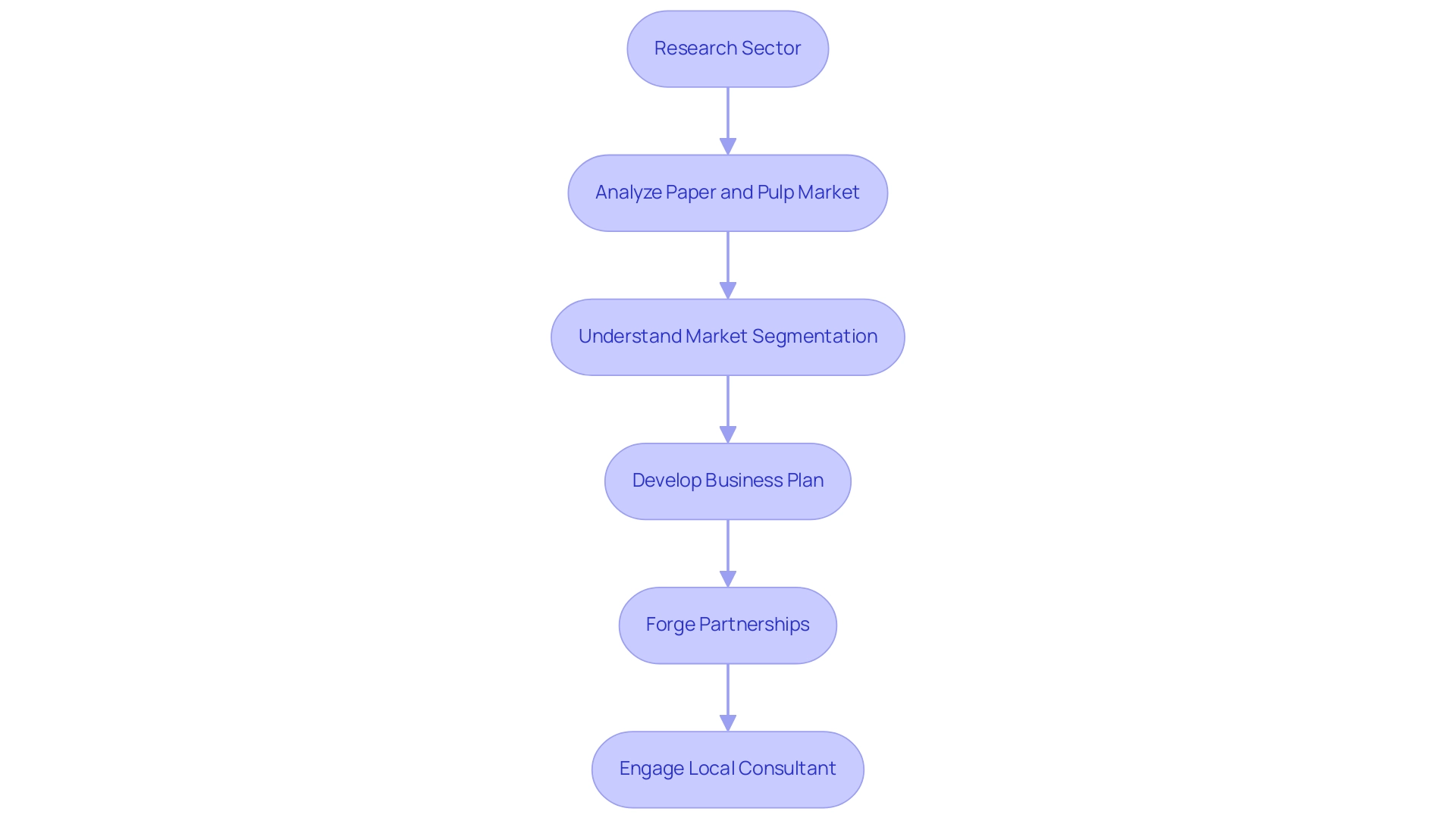
Navigating Regulatory and Legal Requirements for Factory Setup
To successfully establish a factory in Malaysia, it is essential to thoroughly research the guidelines set forth by the Malaysian Investment Development Authority (MIDA) for factory Malaysia. This authority plays a pivotal role in guiding businesses through the regulatory landscape. Securing the appropriate permits is crucial; these typically include:
- Environmental licenses
- Business licenses
- Factory operating licenses
Notably, companies with shareholders' funds not exceeding RM2,500,000 and/or not employing 75 or more full-time employees must comply with the ICA 10 form, which is a critical regulatory requirement. Compliance with local labor laws and safety regulations is not only mandatory but also vital for promoting employee welfare and ensuring the smooth operation of your business. As Prime Minister Anwar Ibrahim stated, since taking office in November 2022, his government has made strides to reduce government influence over corporate boards, which can positively impact regulatory transparency and efficiency.
Furthermore, government strategic investment funds in the country are signatories to the UN-supported Principles for Responsible Investment (PRI), emphasizing the importance of ESG considerations in investments—an essential aspect for D2C brand owners. Consulting with a legal expert well-versed in factory Malaysia production laws can significantly streamline the process, ensuring that all regulatory requirements are met effectively. This proactive approach is particularly important as the country continues to enhance its governance standards through its participation in OECD corporate governance engagements, aiming for full adherence to the OECD Guidelines on Corporate Governance for State-Owned Enterprises (does), which serves as a real-world example of the governance improvements being made.

Choosing the Optimal Location for Your Factory
When assessing potential production sites in Southeast Asia, D2C brand owners should take into account important factors such as:
- Closeness to suppliers
- Access to transportation networks
- The position of target consumers
This strategic assessment should also include identifying industrial zones in factory Malaysia that offer attractive incentives for new factories, such as tax breaks. Notably, multinational enterprises can benefit from a double deduction on corporate expenditures, amounting to 2 million Malaysian ringgit per annum for three consecutive years, enhancing the financial viability of their operations.
According to Steve Chia, Tax Leader at PwC in the region, these tax incentives significantly enhance the appeal of factory Malaysia as a production center.
Moreover, OpsNinja's expert inspections play a vital role in ensuring quality and reliability in the supply chain, which is crucial for D2C brands looking to prevent product returns. By leveraging their leadership excellence, exemplified by Sajag Agarwal's extensive experience in supply chain management and Rafael Petry's technology expertise, OpsNinja showcases transformative case studies that highlight the positive impacts of enhanced quality control and supplier management on brand performance. For instance, their interventions have led to a 30% reduction in product returns for brands they have worked with, demonstrating their effectiveness.
Furthermore, the factory in Malaysia, combined with the country's membership in ASEAN and its trade agreements with multiple countries, including CPTPP and RCEP, creates additional opportunities for D2C brand owners in terms of market access and reduced tariffs. Analyzing local demographics is essential to ensure access to a skilled workforce in the factory Malaysia, vital for maintaining high manufacturing standards and quality control.
However, it is also important to consider the ongoing challenges related to workers' rights, as highlighted by the case study on exploitation of employees. An Independent Committee on Foreign Workers was established in 2018 to examine policies and suggest enhancements to safeguard foreign workers from exploitation, indicating that working conditions should be a priority for any brand owner.
Conducting a comprehensive SWOT analysis—evaluating the Strengths, Weaknesses, Opportunities, and Threats of each potential site—will provide insights into the best fit for your operational needs. This methodical approach, coupled with OpsNinja's commitment to ensuring quality and reliability in supply chain management, allows D2C brand owners to make informed decisions that align with both their business objectives and the competitive landscape of the region.
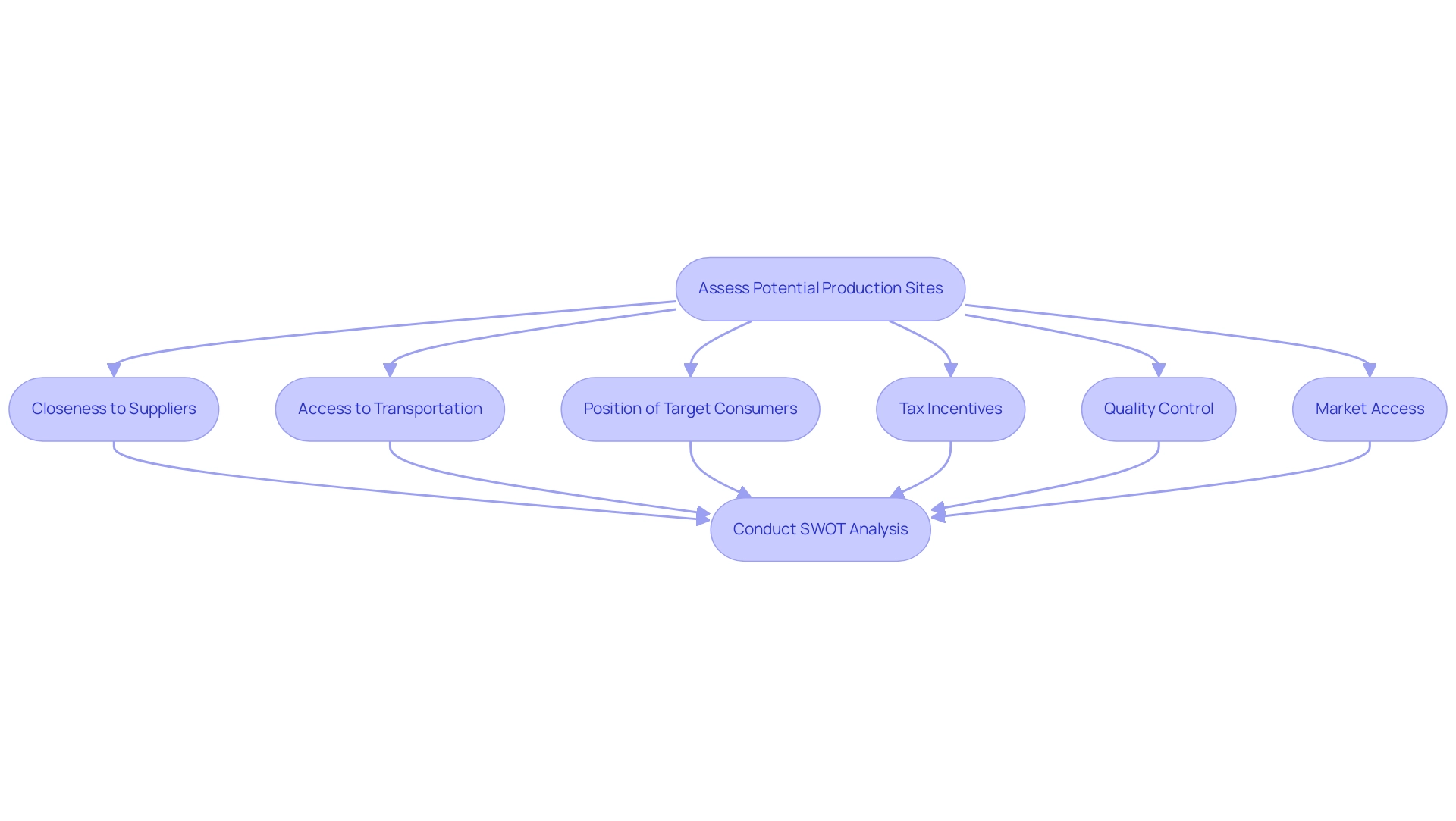
Understanding the Local Workforce and Labor Market
To effectively navigate the local labor environment in Malaysia, it is crucial to thoroughly research the availability of skilled workers relevant to your industry. With the manufacturing sector generating over 20,000 jobs in Q3 2024, understanding workforce demographics, wage expectations, and training initiatives is essential. Notably, Kedah boasts the lowest unemployment rate at 1.6%, followed closely by:
- Selangor (1.9%)
- Pulau Pinang (2.0%)
- W.P. Putrajaya (2.0%)
Engaging with local recruitment agencies can provide valuable insights into these dynamics, facilitating informed hiring decisions. Furthermore, establishing partnerships with local educational institutions can create a sustainable talent pipeline, ensuring a steady influx of qualified candidates.
Such collaborations not only enhance workforce readiness but also align training programs with industry needs. As noted by workforce expert Fashion, excessive tightness in the labor sector was expected to dissipate such that underlying wage growth gradually moderates, while labor productivity should pick up, further dampening the pace of unit labor costs increases. This viewpoint emphasizes the importance of being aware of employment trends.
Additionally, recognizing cultural factors that influence employee engagement and retention strategies is vital for fostering a motivated and committed workforce in this competitive landscape. For instance, the case study titled 'The Power of Language: Rohingya Interpreters give Refugees a Voice' illustrates the critical role of effective communication in workforce engagement. Moreover, recent updates from IOM emphasize ongoing trends in workforce availability, further informing strategies for navigating the sector's labor market.
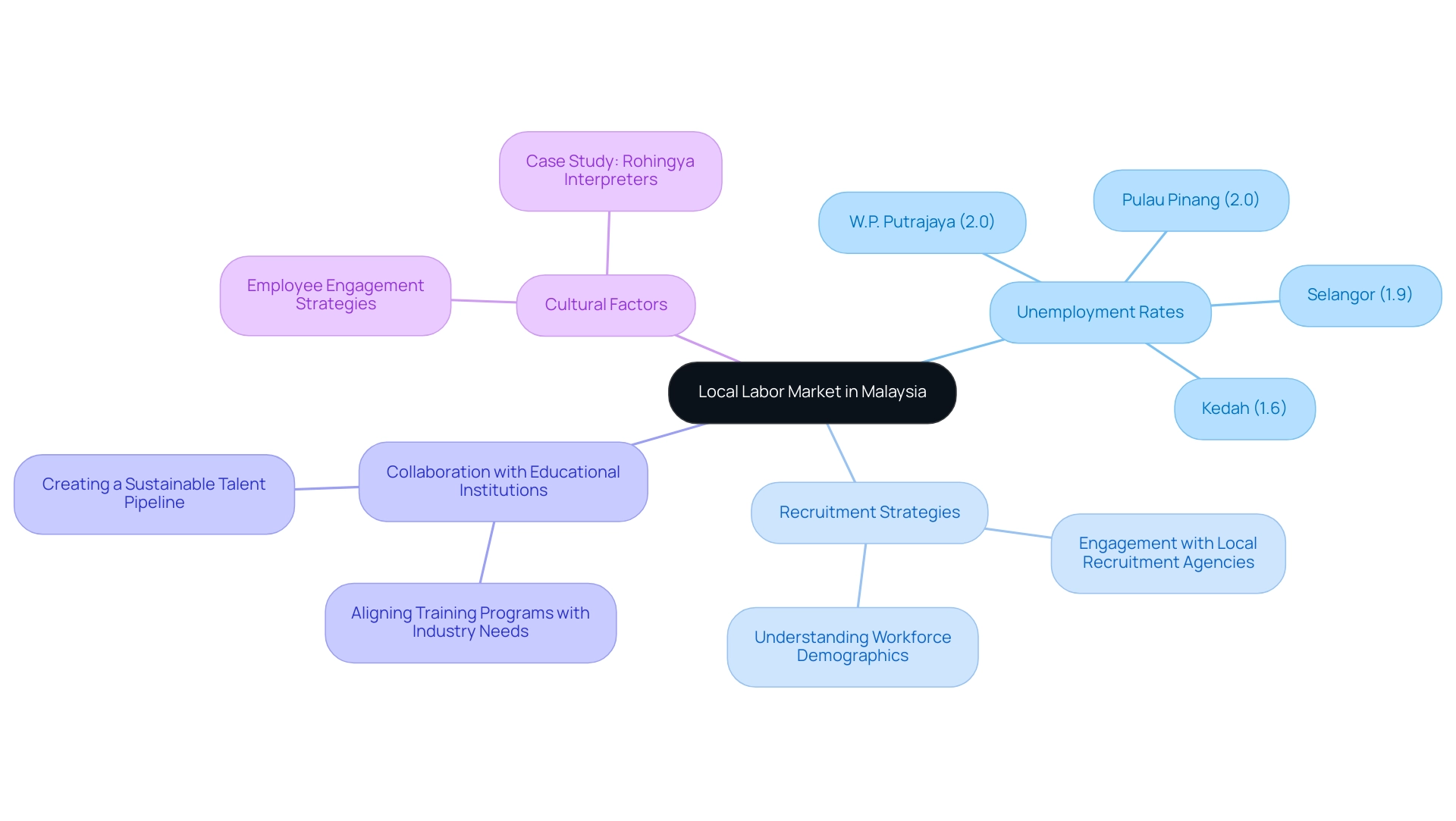
Financial Planning and Budgeting for Factory Establishment
To effectively establish a factory in Malaysia, it is essential to develop a detailed budget encompassing critical costs such as:
- Land acquisition
- Construction
- Equipment purchases
- Operational expenses related to the factory in Malaysia
A thorough cost breakdown will not only provide clarity but also facilitate informed decision-making. Recognizing possible funding sources is similarly important; choices may encompass:
- Government grants designed to promote industrial growth
- Bank loans suited for startup companies
- Private investors attracted to the sector's potential
A well-structured financial forecast should outline expected revenue, expenses, and profit margins over the first three to five years, allowing for a clear vision of the financial landscape. Historically, research on Malaysia's manufacturing sector from 1980 to 2009 reveals that real wages and workforce productivity are cointegrated, exhibiting a non-monotonic relationship. This suggests that increases in real wages do not always improve productivity, emphasizing the significance of strategic financial planning.
Additionally, considering the mean temperatures in Selangor (1.444) and Negeri Sembilan (1.267) can impact operational considerations and energy costs in establishing a factory in Malaysia. Regularly reviewing and adjusting your financial plan in response to changing circumstances ensures ongoing viability and positions your business for success in a dynamic market. As noted in a case study, labor productivity in the production sector is projected to reach 314.3 thousand Euros by 2025, highlighting the efficiency and value of effective financial planning.

Selecting Technology and Equipment for Efficient Operations
To effectively evaluate your production needs, it is crucial to identify the specific types of machinery and technology that will best serve your operations. Begin by researching suppliers that provide reliable and efficient equipment tailored to your requirements. It is equally important to evaluate the long-term maintenance and operational costs associated with your equipment choices to ensure financial sustainability.
As technology progresses swiftly, with substantial investments from international tech leaders like Microsoft and Google in the region, staying informed about the latest advancements is essential. Significantly, the deployment of 5G coverage across the nation is anticipated to improve connectivity and assist contemporary production activities, enabling the use of more advanced equipment and processes. Additionally, understanding the commercial vehicle production volume trends from 2016 to 2024 can provide valuable market insights that inform your machinery choices.
Implementing digital tools, particularly ERP (Enterprise Resource Planning) systems, can greatly enhance inventory management and quality control processes, streamlining your operations. According to Kawal Preet, President for Asia Pacific, Middle East and Africa at FedEx Express, the pace of technological advancement is astonishing, necessitating careful consideration in equipment selection. Furthermore, analyzing the case study of the petroleum and chemicals production sector reveals how technology selection has significantly influenced GDP contributions and export volumes in the country.
Ensure that the technology you select is scalable to support future expansion, positioning your factory Malaysia for success in the competitive environment of production.
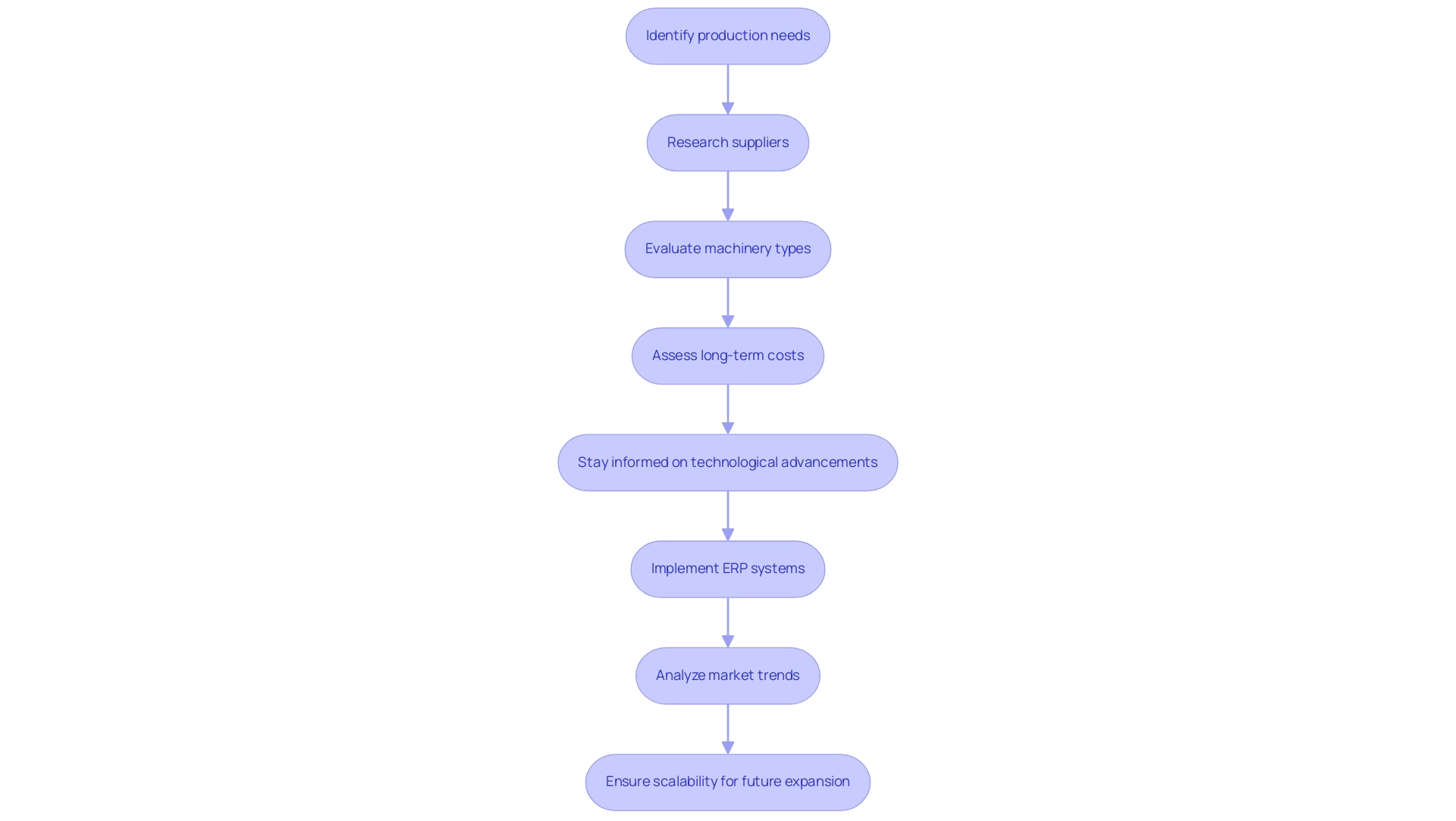
Incorporating Sustainability Practices in Factory Operations
A thorough evaluation of the operations at your factory Malaysia is essential for identifying opportunities to enhance sustainability, particularly in:
- Energy efficiency
- Waste reduction
- Resource management
Given that Malaysia is ranked among the 30 most polluted countries, the urgency for implementing sustainable practices is more critical than ever. Practices such as:
- Recycling programs
- Utilizing energy-efficient machinery
- Sourcing materials sustainably
can significantly contribute to these goals.
Furthermore, insights from the case study titled 'The Effect of Green Behavior and HRM on Environmental Performance' highlight that fostering employee green behavior and implementing green human resource management can lead to improved environmental performance in factory Malaysia industries. Engaging employees in sustainability initiatives fosters a culture of environmental responsibility, ensuring that your workforce is aligned with your sustainability objectives. Pursuing certifications like ISO 14001 can serve as a testament to your commitment to environmental management, enhancing your brand's reputation in an increasingly eco-conscious marketplace.
As sustainability expert insights suggest, 'It is crucial for companies or brands to be transparent and proactive on addressing the world’s environmental and social problems.' By adopting these strategies, including integrating CSR principles and cultivating greener leadership, your organization can not only improve operational efficiencies but also position itself as a leader in sustainable manufacturing practices within the factory Malaysia.
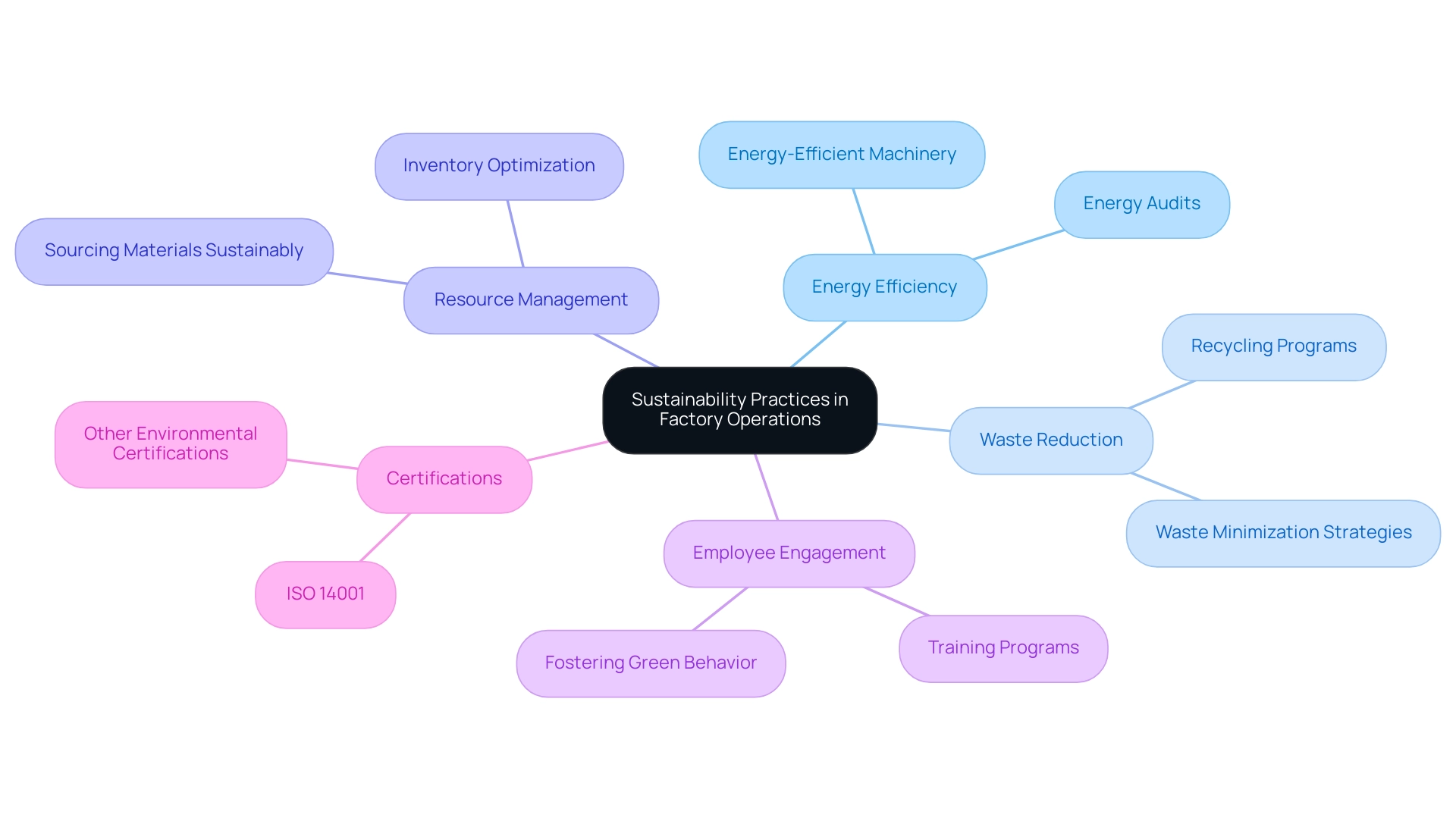
Conclusion
Establishing a factory in Malaysia offers substantial opportunities, particularly in the expanding paper and pulp market. A thorough market research foundation is key for identifying investment prospects and crafting effective business strategies. A well-defined business plan combined with strategic partnerships is essential for operational success.
Navigating the regulatory environment is crucial, as compliance with the Malaysian Investment Development Authority's guidelines ensures smoother operations and fosters corporate governance. The increasing focus on environmental, social, and governance (ESG) criteria highlights the need for responsible investment practices.
Choosing the right location and understanding the local workforce are critical for maintaining high manufacturing standards. Collaborating with local recruitment agencies and educational institutions can develop a sustainable talent pipeline. Additionally, sound financial planning and the selection of appropriate technology enhance operational efficiency, enabling factories to adapt to market changes.
Incorporating sustainability practices is vital for long-term success. Emphasizing energy efficiency, waste reduction, and employee involvement in sustainability initiatives not only boosts operational performance but also positively impacts the environment.
In summary, a comprehensive approach that integrates market research, regulatory compliance, workforce dynamics, financial planning, and sustainability is essential for establishing a successful factory in Malaysia. By adopting these strategies, D2C brand owners can position themselves advantageously in a competitive landscape, paving the way for growth and success in this dynamic market.



